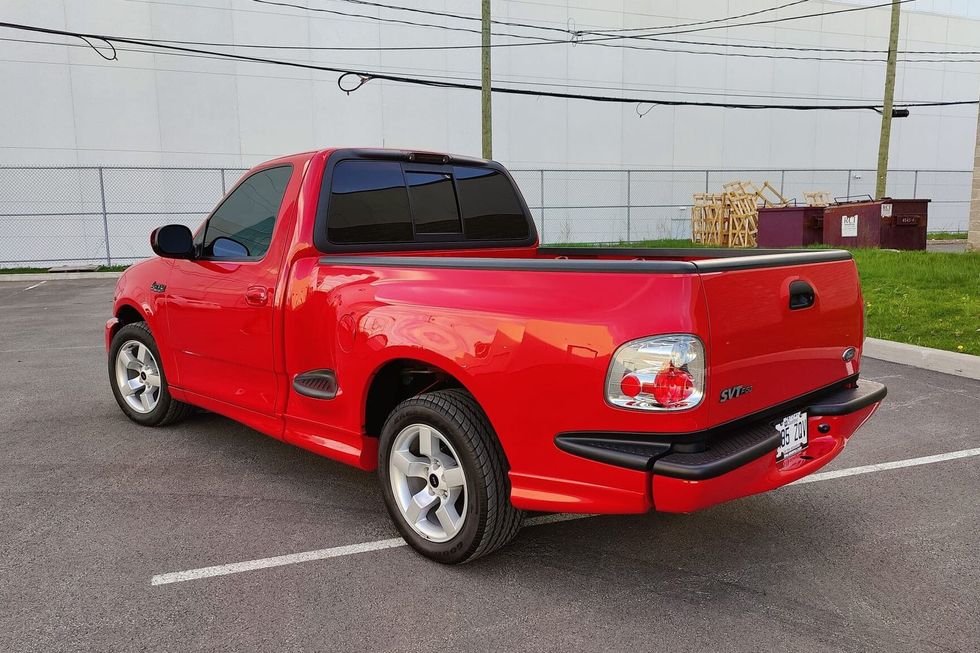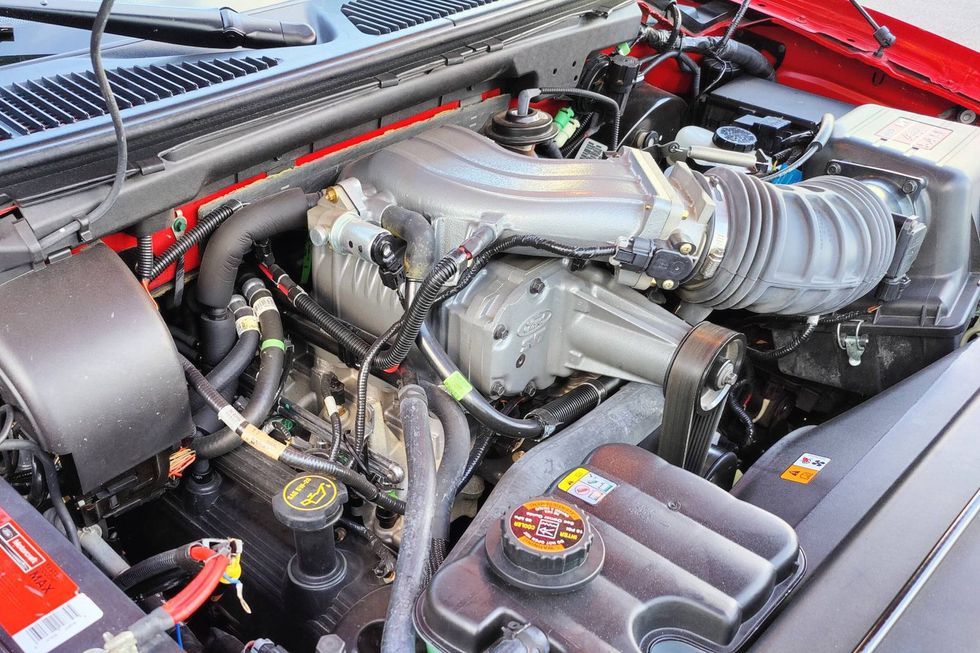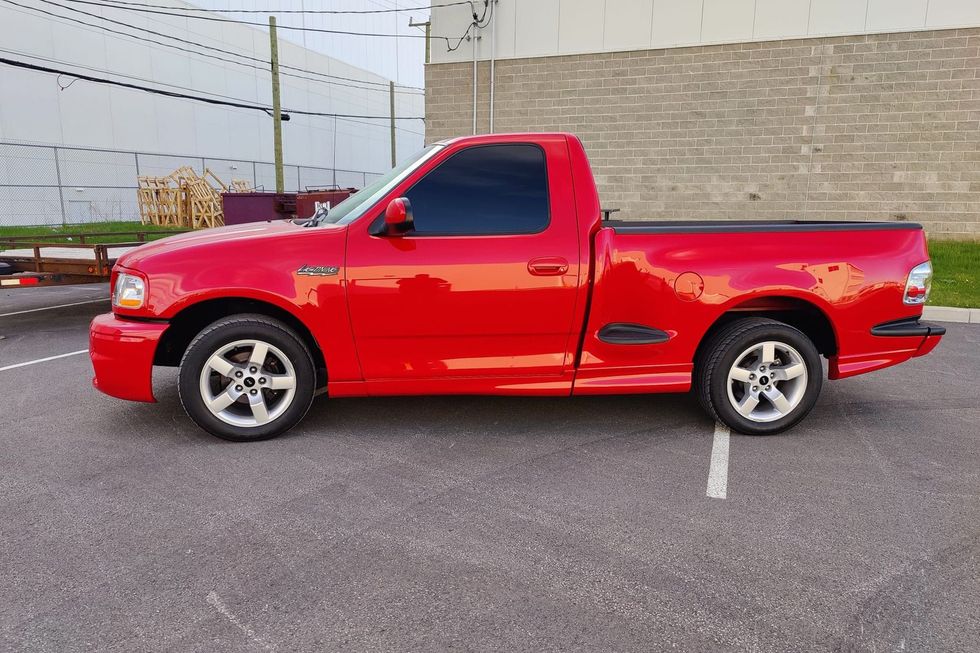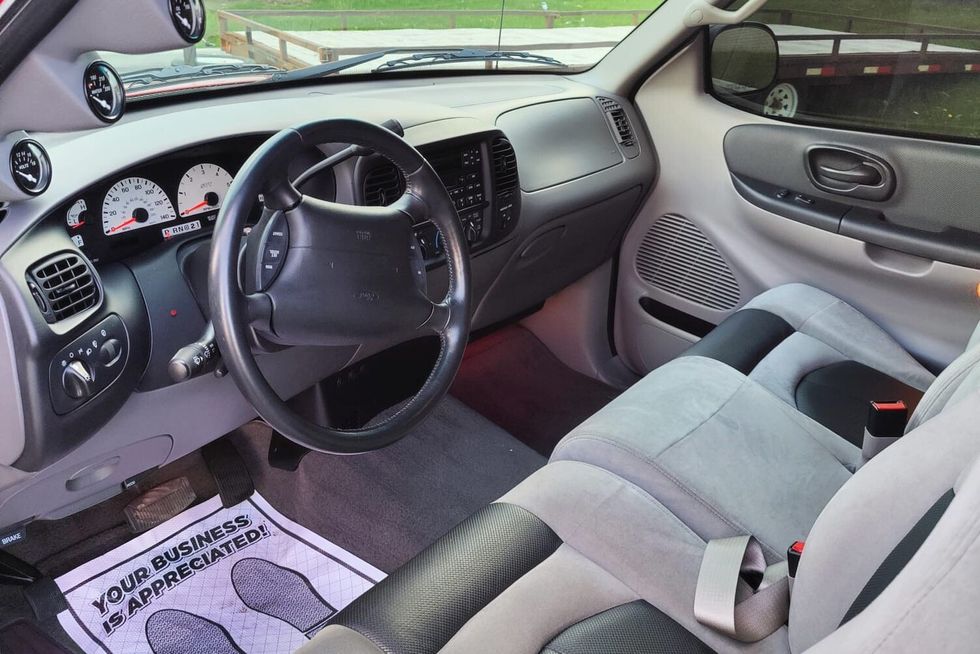Safari Sensation - 1955 Pontiac Safari
For the family that wanted a hardtop but needed a station wagon, the 1955 Pontiac Safari offered the best of both worlds
09/22/2018


For the first 20 years after the end of World War II, luxury and sportiness went together. The ideal of the casual yet comfortable lifestyle was found in everything from vacation advertising to clothing to architecture, and particularly in the automobile. Nearly every body style was revamped between 1949 and 1957 to reflect that uniquely '50s American paradigm of sporty luxury--roadsters returned as sports cars, coupes
became hardtops, sedans spawned four-door hardtops, pickup trucks turned into coupe utilities and, perhaps most shockingly, the workaday station wagon was reworked into the sport wagon.
General Motors' Pontiac Division was heartily in need of its own reinvention by the early 1950s. The conservative, semiformal image of Pontiac's cars was mired in the division's prewar niche between basic Chevrolet and slightly more formal Oldsmobile. But Oldsmobile had undergone its own sporty rework with the introduction of the V-8-powered Rocket 88 for 1949, and Pontiac was looking increasingly stodgy and out of place.
While much has been written about the 1955 Chevrolet, the 1955 Pontiac often gets forgotten in the shuffle. Many buyers at the time found it more attractive than the cheaper Chevrolet, and in a number of respects it was a superior vehicle. Further, it was nearly as big a transformation for the Pontiac division as the 1955 Chevrolets were for Chevrolet--beginning a wholesale reinvention of the division that would continue through the debut of the Wide Track models in 1959.
All 1955 Pontiacs used the completely new A-platform shared with Chevrolet. Similar roofline and wrap-around windshield aside, the Pontiac body was unique in all respects from the beltline down and included a longer front end (and correspondingly longer wheelbase) featuring a massive, divided-bumper grille. What did return were the division's trademark Silver Streaks on the hood along with matching finned trim sections along the top of the rear fenders.
The Pontiac Safari, like its corporate cousin the Chevrolet Nomad, had its origins with the 1954 Motorama Nomad, which was a fantasy Corvette-based two-door station wagon. While the Motorama Nomad was never intended for production, it was teased in order to whet the public's appetite for something more than the four-door family haulers that were the standard station wagon offerings up to then.
Both the Safari and the Nomad were envisioned as a marriage between the good looks of a pillarless hardtop and the utility of a station wagon. As such, both models shared their front doors with the two-door hardtop in each division. Also like the Nomad, the Safari was the most expensive body style available in its division, outpricing both the Chieftain 870 four-door station wagon and the Star Chief convertible. That pricing premium, along with a late introduction, probably explains why the Safari was also the lowest-production Pontiac for 1955, with only 3,760 examples produced.
One great advantage that the production Safari had over the Motorama Nomad and Pontiac's own 1954 Motorama Dream Car, the Bonneville, was its brand-new, 287-cu.in. V-8. Called the Strato-Streak, this new engine was originally slated to be available for the 1953 model cars, but it was delayed due to the accidental death of Pontiac General Manager Arnold Lenz. The V-8, Pontiac's first since the division used up leftover Oakland V-8s in 1932, shared nothing with the staid flathead six- and eight-cylinders that were the division's engines of choice since the early 1930s. Nor did the new V-8 share anything with any other GM division's engine, save for the stud-mounted rocker arms that Chevrolet division was allowed to pirate for its own new V-8.
The 287-cu.in. engine was initially available only with a single two-barrel carburetor and single exhaust. With the manual transmission, buyers received solid lifters, 7.4 compression and 173 horsepower. Those who opted for Hydra-Matic drive received hydraulic lifters, 8.0:1 compression and 180 horsepower. Later in 1955, when Chevrolet debuted its own 180hp V-8, Pontiac concocted a 200-horsepower Power Pack engine that mounted a four-barrel carburetor, though still only with a single exhaust.
While a column-shifted three-speed manual was the standard transmission, 90.6 percent of 1955 Pontiac production had the Hydra-Matic automatic transmission. Hydra-Matic, available in Pontiacs since 1948, was in its last year before its substantial 1956 redesign into the Controlled Coupling Hydra-Matic. The early Hydra-Matics would later become valued by drag racers for their firm, substantial shifts, but contemporary car journalists and owners often complained about the "lurching" full-throttle upshifts of the early design transmission.
While the 1955 Pontiac received a redesigned chassis, it was built upon the same kingpin-equipped independent front suspension technology used under the 1954 cars, but with improved geometry to suit modern driving conditions. Kingpin inclination was changed from a 5-degree inward tilt to vertical, resulting in lowered steering effort--although potentially at the expense of handling. In the rear, parallel leaf springs continued to suspend an open-drive axle, as had been Pontiac convention since before World War II. Following a practice begun in 1954, Pontiac offered two different wheelbases: 122 inches for the Chieftain line, and 124 inches for the Star Chiefs. Although the Safari was a part of the Star Chief line (it was, in fact, the only wagon offered in Star Chief trim), it used the Chieftain's shorter wheelbase and did not have the extended rear overhang found on Star Chief sedans, convertibles and Catalina hardtops.
Our Turquoise Blue and White Mist feature car was sold new in Pennsylvania and came equipped with power brakes, the Venti-Heat underseat heater and defroster, AM radio, back-up lamps, "No-Mar" fuel guard door trim, an outside rearview mirror, oil-bath air cleaner and Hydra-Matic drive. The original owner selected a harmonizing turquoise-and-white interior in leather, although nylon-and-leather was also an option. The current owner has added the much-loved illuminated hood ornament, which was still optional in 1955.
Owner Barry Zalesky, of Boynton Beach, Florida, is no stranger to sport wagons or 1955 Pontiacs. Barry's father drove a Star Chief sedan when Barry was a child, and Barry himself had a 1955 Chevrolet Nomad in college. One day, while driving his Nomad, he had his first encounter with a Safari. "A guy passed me in a black-primer '55 Safari wagon. I caught him at a light and I said, 'What did you do to that Nomad? How did you get those quarters on that wagon?' And, of course I saw they were Pontiac taillamps. And he said to me 'No, this isn't a Nomad; this is a Pontiac. This is a Safari wagon.' I said, 'What are you talking about? Pontiac never had a two-door wagon!' and he said, 'They certainly did!'"
Barry went on to tell us: "So I followed him. He didn't work very far from where I lived, so I stopped and asked him if I could look at the car. He said, 'Sure, look at the dashboard. That's a Pontiac dashboard.' And sure enough, it was. Years later, I started to enquire about Safaris. I saw them listed in Hemmings ... and I saw the ad for the Pontiac-Oakland Club International. I joined the Safari Chapter and that's how I started the search for my car."
In July 1984, after a two-year search, an ad in the POCI's Smoke Signals magazine netted a response from Scranton, Pennsylvania, not far from Barry's then-home in Philadelphia. Barry found a one-owner car resting in a barn in very good condition, requiring only minor mechanical repairs to be functional. After attending to the negligible issues, Barry soon had the car back in service attending local car shows and cruises.
Although it hasn't required much over the years, and Barry only puts about 1,200 miles on the car annually, he has carefully addressed any issues. Routine maintenance has seen many fluid changes, belt and hose replacement, tune-ups and brake service at Barry's hand. He farms out bigger projects to professionals. The factory paint was replaced with a basecoat/clearcoat respray in 1994, with Barry's careful supervision resulting in a finish that reflects the lower levels of gloss found on 1950s lacquer paintwork. Before Barry left Philadelphia and retired to Florida, he had a local trim shop custom-dye turquoise-and-white hides to replace the dried-out original leather.
Since then, Barry has also had the original Bendix Treadle-Vac brake booster restored in 2014 and had the Hydra-Matic gone through by a local shop at 102,000 miles. He reports the latter effort has made the Safari shift "like a new car."
The 1950s were a transitional time in American automobiles between 1930s and '40s technology that feel antique to a modern driver and the designs that make 1960s cars feel positively modern. The Safari fits squarely in the middle of that spectrum. If it had a manual transmission, the Safari would still sport through-the-floor brake and clutch pedals, but Hydra-Matic-equipped Pontiacs began using a pendulum-style brake pedal starting in 1954.
Potentially confusing to modern drivers is the non-standard (N-ΔDrΔ-Lo-R) gear-shift pattern on the early Hydra-Matics and lack of a "Park" position (a parking pawl is engaged with the transmission in Reverse). Barry avoids confusion by parking the Safari in Neutral and setting the "cane-handle" (i.e. T-shaped) parking brake lever found under the left side of the dashboard. Since the car must be started in neutral, this is doubly advantageous.
Younger drivers may find themselves scrambling for a minute to find a seatbelt, but they weren't offered in Pontiacs in 1955, and Barry hasn't installed them. The flat, leather-covered bench seat is comfortable, but unlikely to hold the driver and passengers in place under spirited cornering. That said, it would be a few years before Pontiac incorporated ball joints and widened wheel tracks into its suspensions, so the interior is well suited to its original use. Barry reports that even after 500 miles, he rarely has any complaints with the interior's comfort.
Starting procedure is fairly typical: Mash the accelerator to the floor once and let up (No pumping! You'll flood it!), twist the key located low on the instrument panel to the right of the steering wheel, and the engine should come to life. Put your foot on the brake pedal, which contemporary road testers praised for width allowing left-foot braking, release the parking brake, shift into ΔDr and off you go.
The ΔDr position on the gear selector is the normal driving position, "for improved fuel economy," according to the owner's manual. The DrΔ position, on the other hand, is said to be good "for faster acceleration and driving in congested traffic." These are, of course, the dual ranges that give the Dual Range Hydra-Matic its name. Particularly performance-minded drivers discovered a gearshift tango that involved starting in ΔDr for first gear, moving the selector to Lo for an extended second-gear, and then shifting back into ΔDr at peak RPM. That would be good fun, perhaps, but not the way Hemmings treats other folks' collector cars.
Once out on the road, the Pontiac exhibits good manners, absorbing bumps readily while remaining steady. Barry says he wishes the original owner had opted for power steering, but that's strictly because the Pontiac can be a bit of a bear to maneuver at low speeds. At anything over 5 or 10 miles per hour, you're unlikely to notice except that perhaps the unboosted steering has a bit more road feel. The 20-year-old bias-ply tires don't encourage hard maneuvering, but the car tracks straight, and it's easy to see why so many families found Pontiacs to be good for road trips.
Speaking of that, despite its sporty good looks, the Safari offers a full six feet of cargo capacity with the back seat folded down and about four feet with the back seat upright. The cargo bay itself has carpet instead of the rubberized mat offered on the Nomad. Not only does this add a little protection for your vintage cooler and rattan picnic basket or your collection of vintage luggage, but it helps to isolate the occupants from road noise a bit better.
A note about Hydra-Matics here. It's often supposed that because the Hydra-Matic is a four-speed automatic, like the more-modern TH700R4 or TH200-4R, it has a fourth-gear overdrive. That's not the case. Fourth gear is direct, so final drive is purely a function of the rear axle ratio. Normally, Star Chiefs received a 3.23:1 rear gear if they were equipped with Hydra-Matic. That's good enough for our Safari to comfortably make freeway speeds.
Watching the 1955 Pontiac's arch-shaped speedometer is almost mesmerizing. Rather than a conventional needle, it uses a red line that gets longer as speeds increase. Less pleasing is the layout of the other instruments, particularly the gasoline and oil gauges, which can be hard to see due to them being blocked by the gearshift lever. All gauges except for the clock, at least, are grouped in front of the driver and don't require much effort to view. At night, the instruments are illuminated by a soft, green light. The glovebox is centrally placed, which is a logical location so the driver can reach his insurance and registration papers if needed. The inside of the glovebox door also sports indentations for beverage containers--although don't try to use them while the car is in motion! They're strictly intended for use at the drive-in.
Safaris have a reputation for overly warm interiors due to all the glass, but visibility is excellent--especially compared with coupes and sedans just a few years older. For dazzling sun, the Safari has the same type of internal sun visors that come on modern cars. But the bright paint atop the instrument panel and the abundance of chrome trim can make for some unpleasant glare. This is nothing a pair of sunglasses and enough driving to get accustomed to it won't take care of, however.
The power brakes on the Safari work well, hauling the wagon down from speed in a seemingly adequate distance. Like all drums, they're prone to fading under heavy or prolonged use, but drive accordingly and all will be well.
The original AM radio is still intact and was another item Barry had restored; he also replaced the antenna. The radio is completely audible when the Pontiac is under way; unfortunately, there's no Buddy Holly or Patti Page on the airwaves around Boynton Beach, so it doesn't get much use.
The Safari as a sport wagon was a short-lived experiment for Pontiac, and by 1957, the division had already begun to apply the nameplate to a premium-level four-door station wagon. It would continue on in that role right up through the end of Pontiac station wagons in 1989. Over the course of the 1955 to 1957 model years, only 9,094 Safari sport wagons were produced in total.
With its right-for-its-time combination of athletic looks, semi-luxury finish and suburban utility, plus standard V-8 power, the legendary Hydra-Matic transmission and fit-and-finish above its Chevrolet cousin, the Pontiac Safari is possibly the best-kept secret of the pre-muscle Pontiacs. For the collector, the Safari offers both competent road manners and classic '50s styling. It deserves to be as well remembered as the Nomad.
Owner's View
I searched for this model for two years. I knew it was a limited-production car. It won an award for design from the Milestone Car Society. It brings back memories of growing up in the '50s and '60s. It's a typical car that many people bought to haul the family in after World War II ended. It drives very well for a 60-year-old car. On the highway, I can do 65 or 70 MPH all day long. It has a large radiator and runs cool all the time. I like the fact that when I attend car shows and cruises, I'm the only one with this model. Many people stop to admire it, ask questions and take photographs.
1955 Pontiac Safari
Specifications
PRICE
BASE PRICE $2,962
PRICE AS OPTIONED $3,467.80
ENGINE
TYPE: OHV V-8, cast-iron block and cylinder heads
DISPLACEMENT: 287.2 cubic inches
BORE X STROKE: 3.75 x 3.25 inches
COMPRESSION RATIO: 8.0:1
HORSEPOWER @ RPM: 180 @ 4,600
TORQUE @ RPM: 264-lb.ft. @ 2,400
VALVETRAIN: Hydraulic valve lifters
MAIN BEARINGS: Five
FUEL SYSTEM: Rochester 2GC two-barrel carburetor
LUBRICATION SYSTEM: Full pressure
ELECTRICAL SYSTEM: 12-volt, negative ground, generator
EXHAUST SYSTEM: Single exhaust and muffler
TRANSMISSION
TYPE: Column-shift four-speed automatic
RATIOS: 1st: 4.10:1
2nd: 2.63:1
3rd: 1.55:1
4th: 1.00:1
Reverse: 4.62:1
DIFFERENTIAL
TYPE: Hypoid drive gears, open
GEAR RATIO: 3.23:1
STEERING
TYPE: Saginaw, recirculating ball
GEAR RATIO: 25:1
TURNS TO LOCK: 4.5
TURNING CIRCLE: 42.6 feet
BRAKES
TYPE: Hydraulic, four-wheel drum, power assisted
FRONT: 12 x 2.25-inch drums
REAR: 11 x 1.75-inch drums
CHASSIS & BODY
CONSTRUCTION: Steel body, separate I-beam steel frame with crossmembers
BODY STYLE: Two-door station wagon
LAYOUT: Front engine, rear-wheel drive
SUSPENSION
FRONT: Independent; unequal-length upper and lower control arms; coil springs; tubular shock absorbers; kingpin steering knuckle
REAR: Solid axle; semi-elliptical leaf springs; tubular shock absorbers
WHEELS & TIRES
WHEELS: Steel with full wheel covers
FRONT/REAR: 15 x 5.5 inches
TIRES: Bias-ply wide whitewalls
FRONT/REAR: 7.60-15
WEIGHTS & MEASURES
WHEELBASE: 122.0 inches
OVERALL LENGTH: 202.9 inches
OVERALL WIDTH: 75.4 inches
OVERALL HEIGHT: 62.5 inches
FRONT TRACK: 58.66 inches
REAR TRACK: 59.05 inches
SHIPPING WEIGHT: 3,746 pounds
CAPACITIES
CRANKCASE: 5-quarts (6 quarts with filter)
COOLING SYSTEM: 24½ quarts with Venti-Heat underseat heater
FUEL TANK: 18-gallons
CALCULATED DATA
BHP PER CU.IN.: 0.627
WEIGHT PER BHP: 20.81 pounds
WEIGHT PER CU.IN.: 13.04 pounds
PERFORMANCE*
0-60 MPH: 13.8 seconds
¼ MILE: 19.7 seconds
TOP SPEED: 102.0 MPH
FUEL MILEAGE: 16.5 MPG (avg.)
*Motor Trend March 1955 road test of 1955 Pontiac Star Chief sedan with Hydra-Matic
PRODUCTION
TOTAL 3,760
Pros & Cons
+ Sport wagon body style
+ Rarer than a Chevrolet Nomad
+ Styling of a hardtop with the utility of a station wagon
- Limited production
- Harder to find trim parts
- Too rare to use as a utility vehicle
What to Pay
Low: $15,000 - $20,000
Average: $40,000 - $50,000
High: $80,000 - $100,000
Club Corner
Pontiac-Oakland Club International
P.O. Box 68
Maple Plain, Minnesota 55359
763-479-3571, www.poci.org
Dues: $39
Membership: 7,500
Antique Automobile Club of America
161 Museum Drive
Hershey, Pennsylvania 17033
717-566-7100, www.aaca.org
Dues: $35
Members: 60,000
Forget Ford’s groundbreaking electric truck for a moment to consider this 2001 Ford SVT F-150 Lightning now offered on Hemmings Auctions. Instead of the dual permanent-magnet motors found in the current electric Lightning, the 1999-2004 SVT Lightning featured a supercharged version of Ford’s 5.4-liter “modular” OHC V8. Rated at 380 horsepower in the 2001-’04 models, it was good enough to make a stock lightning a formidable opponent on the street as well as at the strip.
A follow-up to the original 1993-’95 F-150 Lightning, which was a high-performance version of a standard F-150, the second-generation SVT super truck presented as a more thoroughly developed model with a lot more exclusive components that further differentiated it from the rest of the F-Series lineup. Beyond the engine, the entire suspension and braking system, not to mention aerodynamic body add-ons, were part of the Lightning package from 1999 through 2004. Exclusive interior components were also part of the package.
At the heart of this SVT Lightning is its iron-block 5.4-liter SOHC, 16-valve V8 with a supercharger and an intercooler. The blower helped it deliver 380 horsepower and 450 lb-ft of torque in 2001, up some 20 horsepower and 10 lb-ft from the ’99 and 2000 models. The Eaton supercharged engine delivered peak boost of 8.0 psi and the engine featured an 8.4:1 static compression ratio, down from the standard 5.4 V8’s 9.0:1, which was rated at 260 horsepower and 350 lb-ft.
Power reached the rear 18-inch cast aluminum-alloy wheels via a four-speed automatic, an aluminum driveshaft and a beefy 9.75-inch, limited-slip rear axle with an acceleration-friendly 3.73:1 final-drive ratio, another upgrade for 2001. Car and Driver magazine reported a 0-60 mph time of 5.2 seconds and a quarter-mile in an E.T. of 13.8 seconds at 104 mph—impressive numbers for a 4,600-pound truck. Top speed was a drag-limited 142 mph.

Trucks generally require a suspension that can handle a full load in its bed while also providing competent driving while empty. But if you fancy one designed to a sports-car standard, then something has to give. In the case of the second-gen Lightning, Ford dropped its payload capacity to a mere 800 pounds. A standard 2001 F-150 Styleside carried a 3,180-pound payload rating, while an F-150 Flareside was rated at 2,005 pounds, some two-and-a-half times the Lightning, which featured the short-bed Flareside body. Towing capacity, likewise, was reduced from 8,800 pounds to 5,000 in the Lightning. But the Lightning’s strengths were never its payload or towing capacities, but it’s ability to perform like a sports car.
As a 21st century performance vehicle, however, the second-gen Lightning was also equipped to handle. A half-inch drop at the front was accompanied by SVT-specific coil springs and Bilstein shocks along with an exclusive 31-mm solid anti-roll bar. SVT’s influence continued at the rear with Lightning-specific five-leaf springs and a 23-mm solid anti-roll bar. The Bilstein setup at the rear included the right-rear shock staggered toward the front of the truck to reduce axle hop under heavy acceleration. The four-wheel antilock disc brakes were cribbed from the three-quarter-ton F-250, with 12.1-inch front rotors at the front and 13.1-inch discs at the rear.

As the years go on, fewer and fewer clean, unmolested low-mileage examples are out there, which is why this 2001 Ford SVT F150 Lightning now on Hemmings Auctions caught our attention. Showing just 5,525.5 miles on its odometer at the time of submission, it is said to be in “mint” condition and have an “immaculate” finish in the seller’s words. No modifications are noted to any part of the vehicle. The 18-inch factory alloys don’t appear to have any curb rash, though the Goodyear performance tires may be original. About the only deviations from stock are the tinted windows.
The latest electric-only F-150 Lightning is certainly a quick vehicle in its own right, but this 2001 edition from the engineers at SVT was built for excitement, not range. It was made with an old-school muscle-car vibe along with modern handling and braking. Which Lightning would you look good behind the wheel of?
Take a look at this second-gen Lightning on Hemmings Auctions before the bidding ends.

Spring is here. As the snow melts and the daffodils bloom, it’s time for many vintage cars to emerge from winter hibernation and get back on the road. Thinking of adding to the collection? We have 10 vehicles in spring-like shades of yellow – including cars and trucks, U.S. and European – to catch your eye.

















































